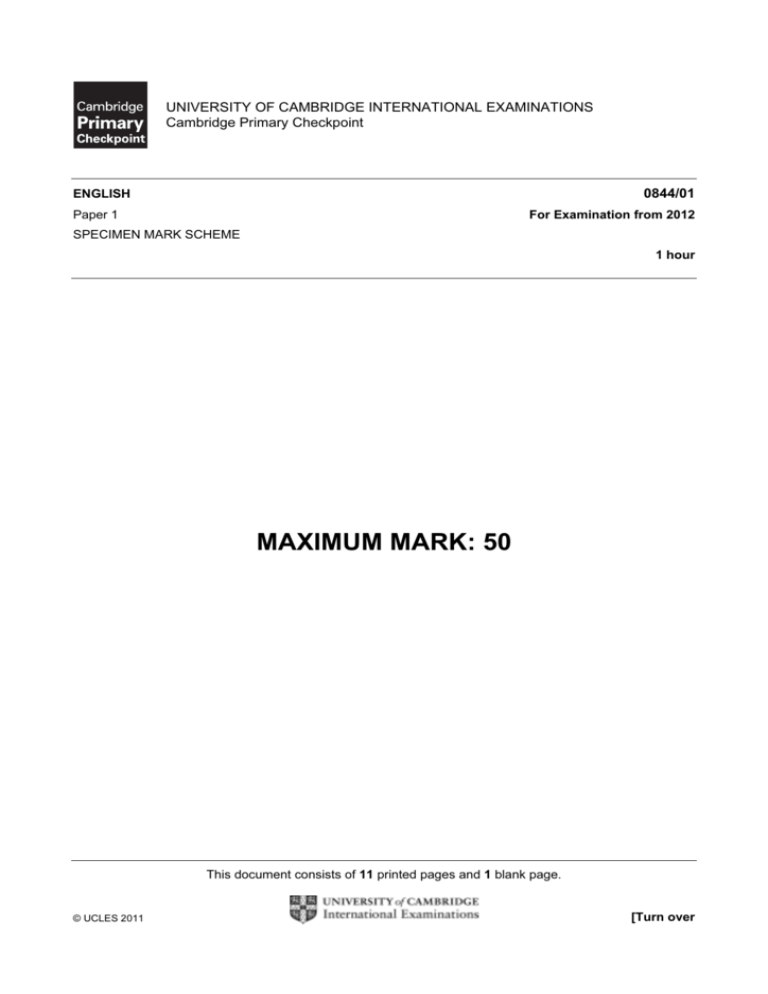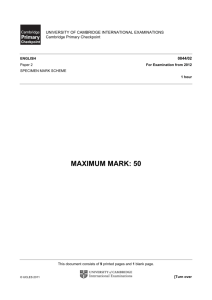Cambridge Primary Checkpoint English P1 Specimen Mark Scheme
advertisement

UNIVERSITY OF CAMBRIDGE INTERNATIONAL EXAMINATIONS Cambridge Primary Checkpoint ENGLISH 0844/01 For Examination from 2012 Paper 1 SPECIMEN MARK SCHEME 1 hour MAXIMUM MARK: 50 This document consists of 11 printed pages and 1 blank page. © UCLES 2011 [Turn over 2 Section A: Reading Question 1 Part Mark 1 Total 1 Question 2 Part Mark 1 Total 1 Question 3 Part Mark 2 Total © UCLES 2011 Answer Further Information from the hard parts of animals / plants Accept individual items as listed, e.g. shells, bones, teeth or wood. Answer Further Information It started (at least) 3500 million years ago. The question is about the origin of life on Earth – answers which describe the glimpse of ancient life do not answer the question. Answer Further Information mud Award 1 mark for each correct tick. sand Award 0 marks if more than two boxes are ticked. 2 0844/01/SM/12 3 Question 4 Part Mark Answer Further Information The summary must contain the information that: Award 2 marks for: • a summary no more than 35 words + ALL the required information. • The study of fossils is called palaeontology. • Fossils show that life on Earth began 3500 million years ago. • A small number of plant and animal species have survived as fossils. 2 e.g. Palaeontology, the study of fossils, shows that life on Earth began 3500 million years ago. Since then only a small number of animals and plants have survived as fossils. Award 1 mark for: • a summary no more than 35 words + only 2 points of information. • a summary between 35 and 40 words + ALL the required information. Award 0 marks for: • a summary over 40 words long. • a summary where there is 1 or 0 points of information. or The study of fossils, palaeontology, shows that life began on Earth 3500 million years ago and only a small fraction of animal and plant species have survived as fossils. or Studying fossils, palaeontology, shows only a small number of plant and animal species have survived as fossils since life began on Earth 3500 years ago. Total 2 Question 5 Part Mark 1 Total © UCLES 2011 Answer It contains mostly facts. Further Information 1 0844/01/SM/12 [Turn over 4 Question 6 Part Mark 1 Answer Further Information If Text 1 ticked: If Text 2 ticked: EITHER: EITHER: - a reference to language as ‘formal’ - a reference to language as ‘informal’ OR: OR: - it is very factual which explains what happens clearly - the words are very descriptive and fun to read (not just ‘fun to read’) Do not award the mark if the answer refers to the information given – there is no distinction. The answer must refer to the style of the language. Do not accept just ‘more interesting’ or ‘more exciting’ on its own or ‘it is easier to read’. OR: - the words create a picture in my mind and make it easier to understand. Total 1 Question 7 Part Mark (a) 1 The Indo-Pacific and/or eastern Mediterranean 1 Accept any two for 1 mark: • spherical / like a sphere / sphere • tear–shaped / tear drop • irregular / uneven (b) Total © UCLES 2011 Answer Further Information 2 0844/01/SM/12 5 Question 8 Part Mark Answer Further Information Black pearls are never found. 2 Total 2 Question 9 Part Mark 1 Total 1 Question 10 Part Mark Award 1 mark for each. Yellow pearls are the most common pearls. Award 0 mark if more than two boxes are ticked. Answer Further Information more time to grow / more space inside the shell Accept answers which acknowledge that there is more space inside the shell (for the pearl to grow). Answer Further Information Organisation/presentation, e.g. (a) 1 • so you know where to look for information. • divides information into parts so it is easier to see. • so it is easier to follow. 1st paragraph (b) 1 nd What do fossils tell us? rd What are fossils? 2 paragraph 3 paragraph Total © UCLES 2011 How are fossils formed? Award 1 mark for all 3 lines drawn correctly. Accept a clear unambiguous indication of the correct answers. e.g. numbers 1, 2 and 3 written in boxes. 2 0844/01/SM/12 [Turn over 6 Section B: Writing (Information Text) 11 PURPOSE AND AUDIENCE TEXT STRUCTURE SENTENCE STRUCTURE Well-crafted paragraphs contribute to control of text; e.g. clear logical links between paragraphs. Use of complex sentences is controlled including the position of clauses to focus attention. PUNCTUATION SPELLING Writing is well-shaped and wholly appropriate to purpose. Clear viewpoint with a clear and consistent relationship between writer and reader established and controlled. 6 The text type is used consistently; e.g. features of report are clear and appropriate to purpose. Relevant ideas and content chosen to interest the reader; e.g. details developed. Range of connectives may be developed, e.g. ‘although’, ‘meanwhile’. 5 The text type is largely sustained; e.g. features of report writing clear. 5 Paragraphs are used to help structure the text and there may be evidence of appropriate links / sub-headings between paragraphs. The writer gives sufficient information for a reader to understand the contents; e.g. some detail with adverbials and expanded noun phrases. Complex sentences are used to create effect, using expanded phrases to develop ideas; e.g. noun, adverbial, adjectival and verb phrases. A wider variety of connectives is used appropriately; e.g. if, so, because, then. 4 Text type is used to convey writer’s attitude to the chosen subject. e.g. knowledge and enthusiasm for subject matter. Some awareness of audience, 5 4 Paragraphs sometimes used to sequence ideas. General features of text type are evident. e.g.: some appropriate features of a report. Use of past and present tense is generally consistent. 3 3 Some attempt to sequence ideas logically; e.g. content clear for a biography. Some variation in sentence openings, e.g. not always starting with noun or pronoun or other word. Each section has an opening statement. Reader given basic information; e.g. relevant statements 2 Some elements of the text type can be seen; e.g.: it is a report 1 4 Some complex sentences are used to extend meaning but not always successfully. Balance of coverage of ideas is appropriate. 3 Sentences are mostly grammatically correct. 2 Ideas grouped together although paragraphs may not be shown. Compound sentences are used but connectives are simple, e.g. ‘and’, ’but’, ‘so’. Commas used in lists and to mark clause divisions. 1 2 2 Simple sentences are generally grammatically correct. ‘and’ may be used to connect clauses. Straightforward sentences usually demarcated accurately; e.g. full stops, capital letters, question and exclamation marks. 1 Award 0 where performance fails to meet the lowest description. © UCLES 2011 0844/01/SM/12 Correct spelling of common words with more than one syllable, including compound words. Sentences demarcated accurately throughout the text. 1 2 Correct spelling of high frequency words. 1 7 Section C: Grammar, Punctuation and Vocabulary Question 12 Part Mark Answer Further Information Bones are the hard parts of some animals. preposition Pearls can be found in the shells of some oysters. adverb Award 2 marks for all 4 lines correctly drawn. 2 Award 1 mark for 2 or 3 lines correctly drawn. Total 2 Question 13 Part Mark (a) 1 Some fossils are beautifully preserved. adjective They are very valuable. pronoun Answer Further Information Award 1 mark for the correct Black pearls are more valuable than white ones underlining as shown. No because they are not as common. other words should be underlined. Award 1 mark for a correctly embedded clause. (b) Total © UCLES 2011 2 Fossils, which may be the skeletons of huge Award 1 mark for correctly dinosaurs, are millions of years old. placed parenthetical commas and the final full stop. 3 0844/01/SM/12 [Turn over 8 Question 14 Part Mark Answer Further Information Fossil hunters search every rock to try to find a fossil. (a) 1 Fossil hunters are searching every rock to try to find a fossil. (b) 2 Total 3 Question 15 Part Mark Award 1 mark for either of these sentences. The pearls (find) are found in oyster shells. First, the oysters (take) are taken from the Award 2 marks for all 3 seabed by divers. correct verbs. They (pull) are pulled onto the deck of fishing boats in nets. Award 1 mark for 2 correct verbs. Each shell (open) is opened to show the pearl inside. Answer Further Information looks / looked carefully The man look very careful in the pile of rocks to find fossils. 1 Total 1 Question 16 Part Mark Award 1 mark corrections. Accept: men carefully The man look very careful in the pile of rocks to find fossils. Answer The fossil is very old. Further Information simple Although the water was deep, the diver found complex the oyster. Total © UCLES 2011 for 1 0844/01/SM/12 both 9 Question 17 Part Mark 1 Total 1 Question 18 Part Mark Answer Further Information Award 1 mark for two correctly placed Pearls can’t be collected if apostrophes. the oysters’ shells are tightly c l o s e d. Award 0 mark if extra apostrophes or other marks are placed. Answer Further Information Also accept: “Yes , “ I replied . “ There were lots of them lying on the beach.” However, if a full stop is used then the ‘t’ must be capitalised as well to gain credit. Also: if the ‘t’ is capitalised, then there must be a full stop. “Did you find this fossil ? “ asked my friend . 2 “Yes , “ I replied , “ there were lots of them lying on the beach.” Also: the question mark, the comma and the full stop must be inside the speech marks. Award 2 marks if 6–7 of the missing punctuation marks are in the correct place. Award 1 mark if 3–5 of them are in the correct place. Award 0 mark if there are 9 or more punctuation marks. Total © UCLES 2011 2 0844/01/SM/12 [Turn over 10 Question 19 Part Mark Answer Further Information Award 1 mark for each appropriate word that retains the sense of the sentence. proportion: share, number, fraction, part, percentage 2 fascinating: enthralling, interesting, intriguing Total © UCLES 2011 2 0844/01/SM/12 Allow use of ‘a’ or ‘an’ before the word for ‘fascinating’, i.e. ‘a interesting’. Also allow different parts of speech. Do not accept words that do not retain the sense of the sentences. e.g. fascinating charming 11 BLANK PAGE © UCLES 2011 0844/01/SM/12





